Dual Monitors for Enhancing Productivity
In today’s fast-paced, digital-first world, maximizing productivity at home has become a top priority.
A dual monitor setup can be a game-changer for anyone who works remotely or simply wants to optimize their computer workspace.
With a well-configured setup, you can streamline tasks, enhance multitasking, and stay organized throughout the day.
If you’re wondering how to set up dual monitors, you’ve come to the right place.
This comprehensive guide will walk you through everything you need to know—from choosing the right equipment to configuring your system for seamless operation.
Along the way, we’ll explore the many benefits of dual monitors and provide actionable tips to help you make the most of your new setup.
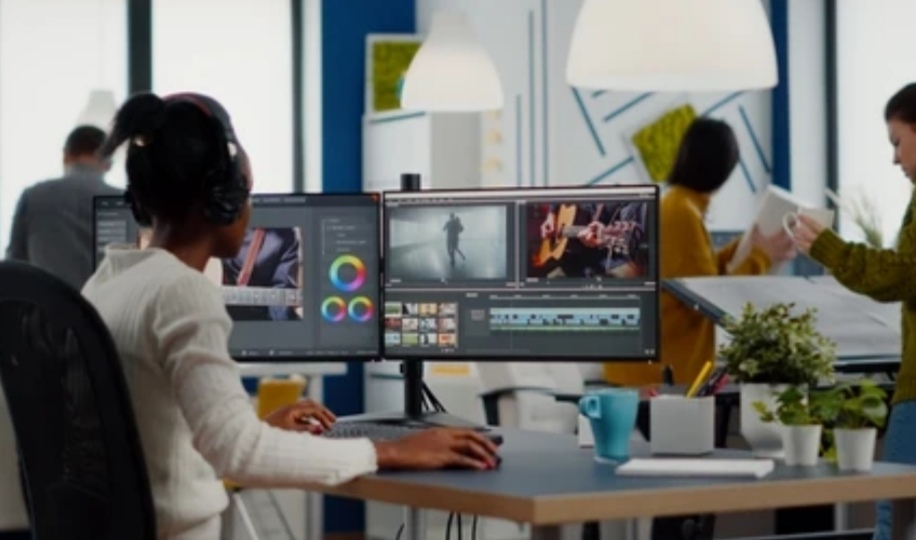
The Benefits of Dual Monitors for Home Productivity
A dual monitor setup isn’t just a trendy tech upgrade; it’s an essential tool for improving focus, efficiency, and organization.
Whether you’re a professional, gamer, or student, adding a second screen can transform the way you work or play.
Enhanced Multitasking Capabilities
One of the most significant advantages of a dual monitor setup is its ability to enhance multitasking.
Imagine the convenience of having your email open on one screen while working on a report on the other.
You can even conduct research in real time without constantly switching tabs.
- Boost efficiency: Switching between tabs or windows can break your flow and waste valuable time. With dual monitors, everything you need is visible at a glance.
- Seamless workflow: Create a dedicated space for different tasks, like one screen for video conferencing and the other for taking notes or referencing documents.
- Ideal for professionals: Whether you’re managing spreadsheets, coding, or designing graphics, having two monitors simplifies juggling multiple tasks.
Adding dual monitors is especially helpful for those in creative or technical fields, such as graphic designers, video editors, or software developers.
Improved Workflow Efficiency
Efficiency is about working smarter, not harder. A dual monitor setup allows you to customize your workspace to suit your specific needs.
- Reduce distractions: By allocating tasks across two screens, you can focus on the work that matters without losing track of secondary tasks.
- Organized work zones: For example, keep your main work on one monitor and supplementary tools, like Slack or Microsoft Teams, on the other.
- Simplified collaboration: If you’re frequently in meetings or sharing your screen, having an additional monitor helps you stay productive without pausing other tasks.
When you’re wondering how to set up dual monitors to maximize efficiency, the key lies in configuring the displays to match your workflow.
Better Organization of Tasks and Applications
Dual monitors provide an unparalleled advantage when it comes to organizing tasks and applications. With a larger digital workspace, you can assign specific screens to individual purposes.
- Dedicated spaces: Use one monitor for project management software like Trello or Asana and the other for video calls or presentations.
- Clear visuals: Spread out multiple windows across the screens without clutter.
- Enhanced focus: Stay on top of tasks by keeping essential applications easily accessible.
This level of organization doesn’t just save time; it also reduces stress by making your workflow more intuitive.
If you’re ready to elevate your productivity and experience the full benefits of a dual monitor setup, start exploring the best monitor deals here.
Don’t wait—unlock the power of dual monitors today!
By following this guide, you’ll learn how to set up dual monitors at home effectively and optimize your workspace for success.
Keep reading to discover everything you need to know.
Understanding the Basics of Dual Monitor Setups
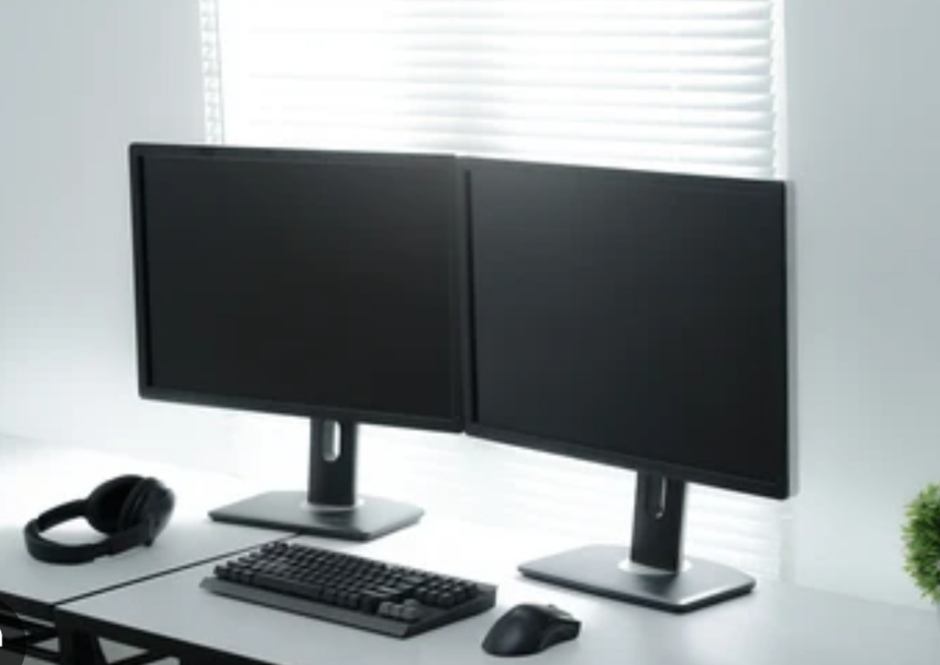
What Is a Dual Monitor Setup?
A dual monitor setup is a configuration where two screens are connected to a single computer, allowing the user to extend their workspace across multiple displays.
This setup is especially popular among professionals, gamers, and students who need more screen real estate to manage multiple tasks simultaneously.
In simple terms, a dual monitor setup enables you to use two monitors side-by-side, either as an extended desktop or as duplicate screens showing the same content.
This flexibility makes it an excellent solution for increasing efficiency and improving productivity.
- Extended Desktop Mode: This mode allows you to spread your work across both monitors, creating a seamless larger workspace. For instance, you can write a document on one screen while researching on the other.
- Duplicate Mode: This option is ideal for presentations or when you want both screens to display the same content. It’s commonly used in educational settings or team collaborations.
Learning how to set up dual monitors is straightforward and requires basic hardware and software adjustments.
Once configured, this setup can transform your work environment into a highly efficient and organized space.
Key Considerations Before Setting Up Dual Monitors
Before diving into the technical aspects of setting up dual monitors, it’s essential to assess your specific needs and ensure compatibility with your equipment.
Here are the key factors to keep in mind:
Compatibility with Your Computer
Not all computers are equipped to handle dual monitors out of the box. To determine compatibility, consider the following:
- Graphics Card Capabilities:
Your computer’s graphics card plays a crucial role in supporting multiple monitors. Most modern laptops and desktops can handle at least two displays, but it’s important to check your graphics card specifications. Look for phrases like “dual-display support” or “multi-monitor capabilities” in the product documentation.
- Operating System Support:
Both Windows and macOS offer robust support for dual monitor setups. On Windows, tools like Display Settings make configuration easy, while macOS provides intuitive options under System Preferences.
- Monitor Output Ports:
Ensure your computer has the necessary output ports, such as HDMI, DisplayPort, or USB-C. If your computer lacks sufficient ports, you may need an adapter or docking station.
Available Ports and Connections
The type and number of ports on your computer and monitors will determine how you connect them. Common ports include:
- HDMI: Widely used for high-definition video and audio signals.
- DisplayPort: Supports higher resolutions and refresh rates, ideal for gamers and graphic designers.
- USB-C: Modern laptops often use USB-C for video output. Ensure your USB-C cable is compatible with video transmission.
- VGA/DVI: Older technologies that may require adapters to connect to newer monitors.
Pro Tip: If you’re using older monitors with VGA ports and your computer has HDMI or DisplayPort, investing in a reliable adapter ensures smooth connectivity.
Desk Space and Ergonomics
Setting up dual monitors requires sufficient desk space and an ergonomic arrangement to ensure comfort and productivity. Here’s what to consider:
- Desk Dimensions:
Measure your desk to ensure it can accommodate two monitors. Opt for adjustable monitor stands or arms if space is limited.
- Monitor Placement:
Position both monitors at eye level and at an equal distance from your seating position. This reduces strain on your neck and eyes during extended use.
- Cable Management:
Keep cables organized with clips or cable sleeves to maintain a clutter-free workspace. A tidy desk not only looks professional but also enhances focus and efficiency.
Ready to upgrade your productivity? Get the best deals on dual monitor setups here and transform your workspace today!
Learning how to set up dual monitors is the first step toward a more organized, efficient, and productive workflow.
Continue reading for a step-by-step guide to help you configure your dual monitor system seamlessly.
Hardware Requirements for Dual Monitor Setups
Setting up dual monitors at home requires careful consideration of the hardware to ensure a seamless and functional setup.
From your computer’s compatibility to selecting the right monitors and cables, every component plays a critical role.
Here’s a comprehensive breakdown of the hardware requirements you’ll need.
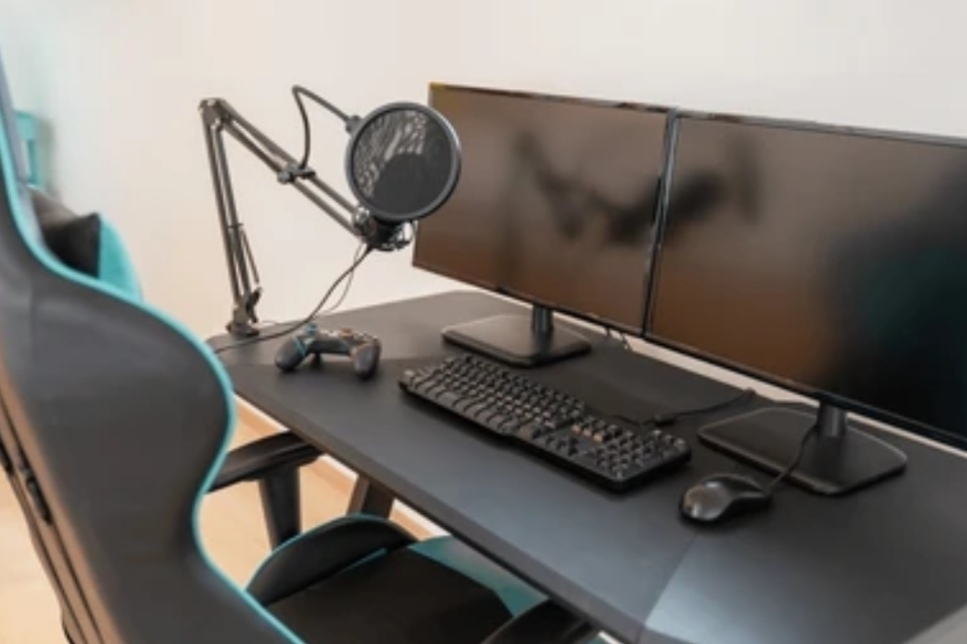
Checking Your Computer’s Compatibility
Before diving into your dual monitor setup, it’s essential to ensure that your computer can handle the additional display.
Compatibility depends largely on your computer’s graphics card and available ports.
Graphics Card Capabilities
Your computer’s graphics card is the backbone of a dual monitor setup.
Most modern graphics cards are designed to support multiple displays, but it’s important to confirm their specific capabilities.
- Integrated vs. Dedicated Graphics Cards:
Integrated graphics cards, commonly found in laptops and budget desktops, may support dual monitors, but they typically have limited power. Dedicated graphics cards, on the other hand, are purpose-built for handling multiple displays and offer better performance.
- How to Check:
Access your computer’s device manager (Windows) or “About This Mac” (macOS) to review your graphics card model. Search online for its specifications to see if it supports dual displays.
Number and Types of Available Ports
Another critical factor is the availability and type of output ports on your computer. These ports serve as the connection points for your monitors.
- Common Ports:
- HDMI: A widely used standard for high-definition video and audio. Most laptops and desktops have at least one HDMI port.
- DisplayPort: Known for supporting higher resolutions and refresh rates, this is ideal for gamers and professionals.
- VGA/DVI: Older options still found on some devices, though they may require adapters for compatibility with modern monitors.
- USB-C/Thunderbolt: Many newer laptops, like MacBooks, use USB-C ports for video output, often requiring a compatible cable or adapter.
Tip: If your computer lacks the required ports, consider using a docking station or an external GPU to expand your connectivity options.
Selecting the Right Monitors
Choosing the right monitors is just as important as ensuring your computer is compatible.
The size, resolution, and type of monitors you select can significantly impact your productivity and overall experience.
Size and Resolution Considerations
The size and resolution of your monitors should align with your specific needs and desk space.
- Monitor Size:
Larger monitors (24–32 inches) are ideal for multitasking, as they provide more screen real estate. If you’re working with limited desk space, opt for smaller monitors (20–24 inches).
- Resolution:
Higher resolutions, like 4K or QHD, deliver sharper images and more workspace. For everyday tasks, Full HD (1920×1080) is sufficient, but creative professionals or gamers may prefer higher resolutions for better detail.
- Refresh Rate:
If you’re using dual monitors for gaming or video editing, consider monitors with higher refresh rates (e.g., 120Hz or 144Hz) for smoother visuals.
Matching or Mixing Monitor Models
When setting up dual monitors, you can choose to either match or mix models:
- Matching Models:
Using identical monitors ensures uniform color calibration, size, and resolution, creating a seamless display experience. This option is highly recommended for professionals working on visual projects.
- Mixing Models:
Combining different monitor models can be cost-effective and allows you to repurpose existing monitors. However, you may encounter inconsistencies in display quality or size.
Necessary Cables and Adapters
The final step is ensuring you have the right cables and adapters to connect your monitors to your computer.
Without the correct connections, your dual monitor setup won’t function.
HDMI, DisplayPort, VGA, and DVI Options
Each monitor and computer combination may require different cables, so it’s essential to understand the options available.
- HDMI Cables:
These are the most common and support both video and audio signals. Use high-speed HDMI cables for resolutions above 1080p.
- DisplayPort Cables:
Ideal for high-resolution and high-refresh-rate setups, DisplayPort is a favorite among gamers and professionals.
- VGA/DVI Cables:
While outdated, these cables are still useful for older monitors and computers. Be prepared to use adapters if your devices only have modern ports.
Adapters for Different Port Types
If your computer and monitors have incompatible ports, adapters can bridge the gap.
- HDMI to VGA/DVI Adapters: Useful for connecting older monitors to newer computers.
- USB-C to HDMI/DisplayPort Adapters: Required for laptops with USB-C video output.
- Docking Stations: These devices provide multiple ports and simplify cable management, especially for laptops.
Ready to upgrade your hardware? Explore the best monitors and cables here to start building your dual monitor setup today!
Knowing how to set up dual monitors with the right hardware is the foundation of a successful, productive workspace.
Keep reading to learn how to configure your system for optimal performance.
Step-by-Step Guide to Setting Up Dual Monitors
Setting up dual monitors might seem like a daunting task, but with the right guidance, you can achieve a seamless, professional setup in no time.
Whether you’re using Windows or macOS, this comprehensive guide will walk you through every step of how to set up dual monitors for maximum productivity.
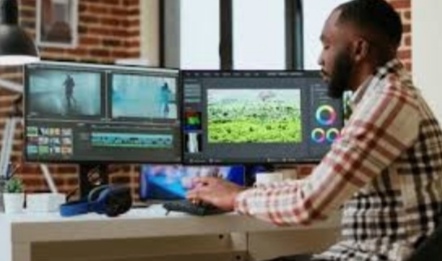
Connecting the Monitors to Your Computer
To begin, you’ll need to physically connect your monitors to your computer.
This process involves powering off your device, securely attaching the necessary cables, and ensuring your system recognizes both displays.
Powering Off Your Computer
Before connecting the monitors, always power down your computer.
This precaution helps avoid any electrical damage and ensures a smooth detection process when you power the system back on.
- Shut down the computer completely rather than putting it to sleep.
- Disconnect the power cable from the wall outlet for added safety.
Connecting Cables Securely
Once your computer is off, it’s time to connect the monitors.
Use the appropriate cables, such as HDMI, DisplayPort, VGA, or USB-C, depending on the ports available on your computer and monitors.
- Insert one end of the cable into the output port of your computer.
- Connect the other end to the input port on your monitor. Repeat this for the second monitor.
- Ensure the connections are tight and secure to prevent display issues.
- If your computer or monitor lacks matching ports, use adapters (e.g., USB-C to HDMI).
Pro Tip: Label your cables to quickly identify them if you need to reconnect in the future.
Powering On and Detecting Monitors
After connecting the cables, power on your computer and monitors.
Your computer should automatically detect both displays, but if it doesn’t, follow these steps:
- Windows Users:
- Right-click on the desktop and select Display Settings.
- Click Detect to manually search for the second monitor.
- Mac Users:
- Open System Preferences and select Displays.
- Click Detect Displays if the second monitor isn’t automatically recognized.
Configuring Display Settings on Windows
Windows makes it easy to customize your dual monitor setup.
By adjusting display settings, you can optimize the arrangement and functionality of your screens.
Accessing Display Settings
To access display settings in Windows, follow these steps:
- Right-click anywhere on your desktop.
- Select Display Settings from the dropdown menu.
- A window will open showing both monitors labeled as “1” and “2”.
Arranging Monitor Positions
Properly arranging the virtual position of your monitors ensures smooth cursor movement across screens.
- Drag and drop the monitor icons to match their physical placement on your desk.
- Align the monitors’ edges in the settings for accurate transitions.
Setting Primary and Secondary Displays
Designating a primary display determines where your taskbar and desktop icons will appear. To set this up:
- Click on the monitor you want as primary.
- Scroll down to the option Make this my main display and check the box.
Adjusting Resolution and Orientation
Fine-tune your monitors’ resolution and orientation for better visuals:
- Use the Resolution dropdown to select the recommended resolution for each monitor.
- Choose between Landscape or Portrait orientation based on your needs.
Configuring Display Settings on Mac
If you’re using macOS, the steps to configure dual monitors are slightly different but just as straightforward.
Accessing System Preferences
To access display settings on a Mac:
- Click the Apple menu in the top-left corner.
- Select System Preferences, then click Displays.
Arranging Displays
Like on Windows, macOS allows you to arrange monitors for a seamless experience:
- In the Displays window, click the Arrangement tab.
- Drag and position the blue rectangles to match your monitors’ physical layout.
Setting the Primary Display
To set a primary display on macOS:
- Go to the Arrangement tab in the Displays settings.
- Drag the white menu bar to the monitor you want to make primary.
Adjusting Resolution and Rotation
For sharper visuals and specialized setups:
- Use the Resolution options to select the best display quality.
- For vertical monitors, enable Rotation to switch between standard and portrait modes.
Now that you know the exact steps to configure dual monitors, why wait? Check out the best dual monitor accessories to complete your setup today!
With the right setup, understanding how to set up dual monitors becomes easy, and the productivity boost is worth every effort.
Optimizing Your Dual Monitor Workspace
A dual monitor setup offers incredible potential for productivity, but optimizing your workspace is essential to make the most of it.
From ergonomic placement to customizing display preferences, here’s how to create a workspace that is not only efficient but also comfortable.
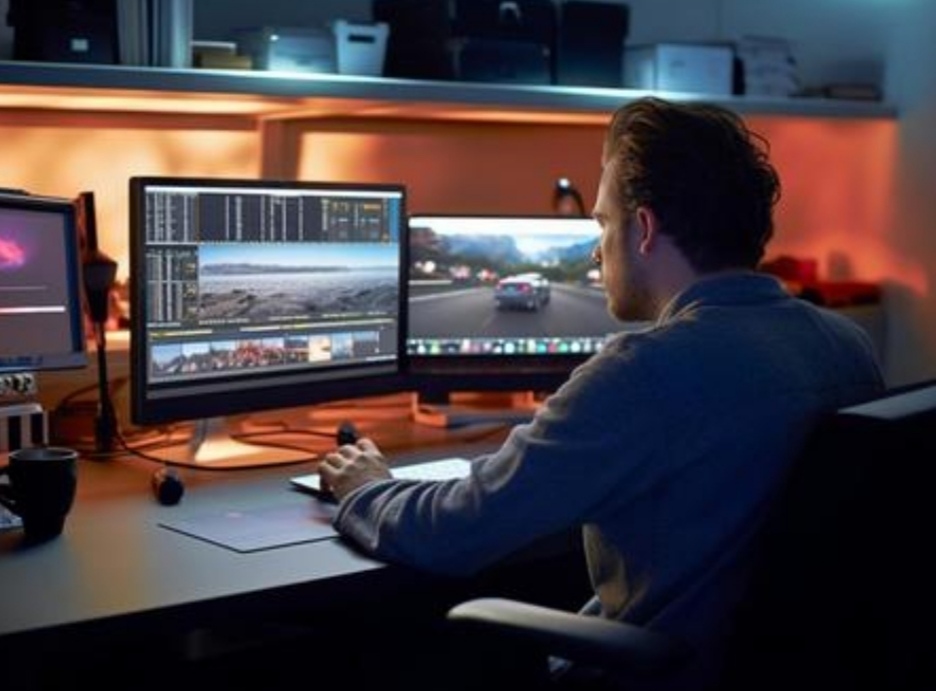
Ergonomic Placement of Monitors
Proper ergonomic placement of your monitors can significantly enhance your comfort and prevent strain during long hours of work or gaming.
Height and Angle Adjustments
Positioning your monitors at the correct height and angle is crucial for reducing neck and eye strain.
- Height: Ensure the top of the monitor screen is at or slightly below eye level. This allows your eyes to naturally glance downward, reducing strain.
- Angle: Tilt your monitors slightly backward, at an angle of 10 to 20 degrees, to match your natural viewing posture. Avoid placing monitors too far to the left or right to minimize neck twisting.
Consider using an adjustable monitor arm to fine-tune placement for added flexibility. Explore ergonomic monitor arms here.
Reducing Eye Strain
Reducing eye strain is a vital part of maintaining productivity and comfort when using dual monitors.
- Place monitors at least 20-30 inches from your eyes, depending on their size.
- Use blue light filters or night mode to reduce eye fatigue, especially during evening hours.
- Follow the 20-20-20 rule: Every 20 minutes, look at an object 20 feet away for at least 20 seconds to give your eyes a break.
Managing Cables and Desk Space
An organized workspace not only looks better but also helps you focus by eliminating clutter.
Here’s how to manage your cables and maximize desk space effectively.
Cable Management Solutions
Proper cable management is essential for keeping your dual monitor workspace tidy and efficient.
- Use cable clips, zip ties, or cable sleeves to bundle wires and prevent them from tangling.
- Invest in a cable management box to hide power strips and adapters.
- Opt for wireless peripherals, such as keyboards and mice, to reduce cable clutter further.
Pro Tip: Label your cables to easily identify which wire connects to which device.
Organizing Peripherals
Dual monitors often come with additional peripherals like webcams, microphones, or docking stations. Organizing these items ensures a clutter-free workspace.
- Use desk organizers or trays to store frequently used items like headphones or pens.
- Consider mounting less-used peripherals under the desk or attaching them to the monitor stand.
- Keep a dedicated space for charging devices to avoid scattering cables across your desk.
Customizing Display Preferences
Customizing display preferences is the final step in optimizing your dual monitor setup. Tailoring your displays not only improves aesthetics but also enhances functionality.
Taskbar Placement
Deciding where to place your taskbar can streamline navigation between monitors.
- Windows Users: You can choose to extend the taskbar across both monitors or keep it on your primary screen. Access these settings through Taskbar settings in the Control Panel.
- Mac Users: By default, the dock appears on the primary display but can be moved to your preferred monitor via System Preferences.
Wallpaper and Theme Settings
Customizing wallpapers and themes adds a personal touch to your workspace while boosting your productivity.
- Use dual-monitor wallpaper apps, such as Wallpaper Engine or DisplayFusion, to create seamless panoramic backgrounds.
- Match your wallpaper and theme to your workflow, such as calming colors for focus or vibrant hues for creativity.
- Consider productivity-focused themes, like minimalist designs, to avoid distractions.
Your workspace is more than just a desk; it’s your productivity hub.
Discover ergonomic tools and accessories here to transform your dual monitor setup into the ultimate workstation.
With proper organization and customization, mastering how to set up dual monitors becomes effortless, and you’ll enjoy both comfort and efficiency every day.
Troubleshooting Common Dual Monitor Issues
Setting up dual monitors can significantly boost productivity, but occasional technical issues may arise.
Understanding how to troubleshoot these problems ensures a seamless experience and prevents disruptions.
This guide addresses the most common challenges and offers practical solutions for each.
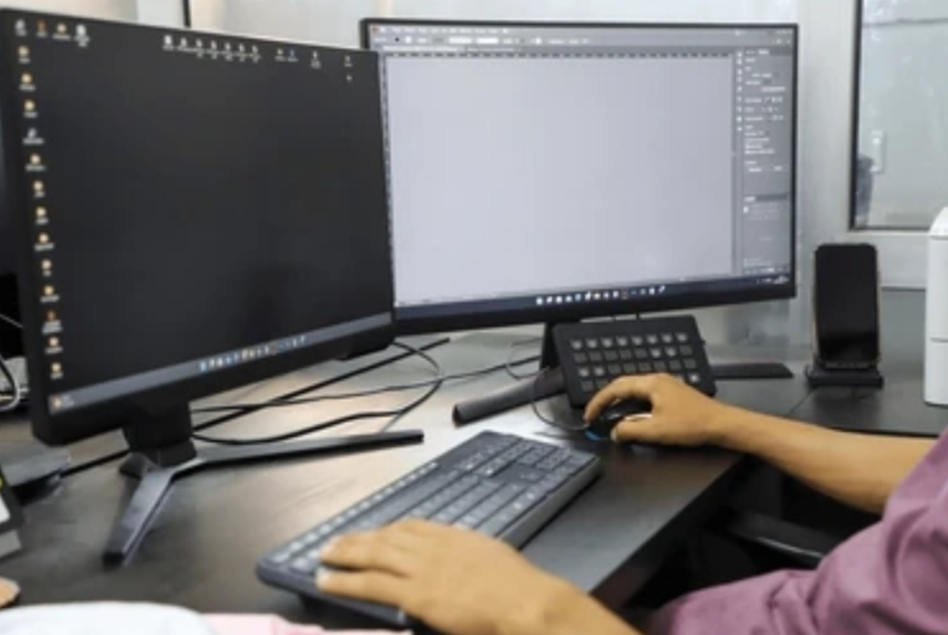
Monitor Not Detected
One of the most frequent issues users encounter is their second monitor not being recognized by the system. Here’s how to resolve it:
Checking Cable Connections
Faulty or loose cables are often the primary reason a monitor isn’t detected.
- Double-check that all cables are securely connected to both your monitors and your computer.
- Inspect cables for signs of wear or damage; frayed wires can lead to poor connectivity.
- Try using an alternate cable (e.g., HDMI, DisplayPort, VGA) to rule out a defective one.
Pro Tip: Ensure your monitor is set to the correct input source (e.g., HDMI or DisplayPort) using the monitor’s built-in menu.
Updating Graphics Drivers
Outdated graphics drivers can also prevent a monitor from being detected.
- On Windows, open the Device Manager, locate your display adapter, right-click, and select Update Driver.
- Visit the official website of your graphics card manufacturer (e.g., NVIDIA, AMD, or Intel) to download and install the latest drivers.
- Mac users can update their macOS software via System Preferences > Software Update to ensure compatibility.
Keeping your drivers up to date ensures optimal performance and prevents compatibility issues when learning how to set up dual monitors.
Resolution or Display Scaling Problems
Incorrect resolution or scaling can result in blurry text, mismatched screen sizes, or unaligned displays. Here’s how to fix these issues:
Adjusting Settings for Each Monitor
Configuring the settings for each monitor individually ensures the best visual quality.
- On Windows, right-click on the desktop and select Display Settings. From here, you can adjust the resolution for each monitor separately.
- Mac users can navigate to System Preferences > Displays to fine-tune their resolution settings.
Tip: Always select the recommended resolution for each monitor to achieve the clearest display.
Ensuring Monitors Are Set to Recommended Resolutions
Using resolutions that don’t match your monitor’s native specifications can result in poor image quality.
- Check the monitor’s manual or specifications to find its native resolution.
- In the settings, ensure that both monitors are set to their recommended resolutions for sharp and clear visuals.
Performance Issues
Running dual monitors can put additional strain on your system, leading to performance slowdowns. Here’s how to address these issues effectively:
Assessing Graphics Card Limitations
Your graphics card must support dual monitors for smooth performance.
- Check your graphics card’s specifications to confirm it can handle two displays.
- For high-performance tasks like gaming or video editing, ensure your GPU has sufficient power and memory.
- If needed, consider upgrading to a more robust graphics card designed for multi-monitor setups.
Explore powerful graphics cards here for better multitasking and smoother performance.
Closing Unnecessary Applications
Running too many applications can overload your system, especially when using dual monitors.
- Close resource-intensive programs like video editing software or games when not in use.
- Use the Task Manager (Windows) or Activity Monitor (Mac) to identify and terminate processes consuming excessive CPU or GPU resources.
Quick Tip: Disable unnecessary startup programs to ensure your system remains fast and efficient when powering on your dual monitor setup.
Don’t let technical hiccups slow you down! Shop for high-quality cables and ergonomic accessories here to make troubleshooting your dual monitor setup a breeze.
With these solutions, mastering how to set up dual monitors becomes a hassle-free experience, letting you enjoy the full benefits of your enhanced workspace.
Enhancing Productivity with Dual Monitors
Utilizing dual monitors effectively can revolutionize your workflow, allowing you to multitask efficiently, manage projects seamlessly, and enhance overall productivity.
Whether you’re working from home or optimizing your office setup, learning how to set up dual monitors is just the beginning.
Here’s how you can maximize the benefits of this powerful configuration.
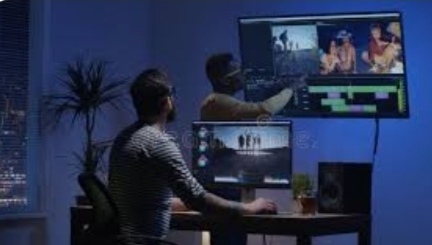
Effective Use Cases for Dual Monitors
Dual monitors can be a game-changer for various use cases. Whether you’re a professional, a student, or a gamer, the versatility of this setup can simplify your tasks and save time.
Comparing Documents Side by Side
For professionals and students, having two screens makes comparing and editing documents much easier.
- Open one document on each screen to review or edit them simultaneously without constantly toggling between tabs.
- This is particularly useful for writers, researchers, and legal professionals who work with large volumes of text.
- Students can keep a research article on one monitor while writing their assignments on the other.
Pro Tip: Use tools like Snap Assist (Windows) or Split View (Mac) to align documents perfectly for side-by-side comparison.
Dedicated Screen for Communication Tools
Keeping communication tools open on one screen ensures you never miss an important message.
- Use one monitor exclusively for Slack, Teams, or Zoom during meetings or collaborative work.
- Monitor emails or notifications while dedicating the second screen entirely to your main tasks.
- This setup is particularly beneficial for remote workers who need to stay connected with their team.
Actionable Tip: Check out webcams and microphones to enhance your video conferencing experience on your second screen.
Enhanced Video Editing Workflows
Dual monitors are essential for creatives, especially video editors, designers, and photographers.
- Use one screen for the editing timeline and the other for a full-screen preview of your project.
- This setup provides more workspace, allowing you to access tools and make edits more efficiently.
- Designers can work on high-resolution projects while referencing inspiration or notes on the secondary monitor.
Pro Tip: Ensure your monitors are color-calibrated for accurate color representation, especially when editing photos or videos.
Keyboard Shortcuts and Tools for Window Management
To make the most of dual monitors, mastering keyboard shortcuts and using dedicated tools can save you time and effort.
These features streamline window management, allowing for quick adjustments and better workflow control.
Snap Assist and Virtual Desktops on Windows
Windows offers built-in tools like Snap Assist and virtual desktops to help you manage your workspace effectively.
- Snap Assist lets you drag windows to the edges of your screen to snap them into place, perfect for organizing multiple applications.
- Virtual desktops allow you to switch between different workspaces, keeping your tasks organized without cluttering your screens.
- Use shortcuts like Win + Left Arrow or Win + Right Arrow to snap windows quickly across monitors.
Pro Tip: Explore tools like DisplayFusion to enhance multi-monitor functionality on Windows.
Mission Control and Split View on Mac
Mac users can benefit from Mission Control and Split View to optimize their dual monitor setups.
- Mission Control provides an overview of all open applications, making it easy to switch between tasks across both monitors.
- Split View lets you run two apps side by side, ideal for multitasking without distractions.
- Keyboard shortcuts like Control + Up Arrow simplify navigation between apps and desktops.
Actionable Tip: Consider BetterSnapTool for more advanced window snapping and arrangement on Mac.
Recommended Software for Multi-Monitor Productivity
Enhance your dual monitor experience with software designed to improve multitasking and customization.
These tools cater to both Windows and Mac users, offering advanced features to streamline your workflow.
DisplayFusion and UltraMon for Windows
- DisplayFusion: A feature-rich software that lets you customize wallpapers, taskbars, and window snapping for multiple monitors.
- UltraMon: Ideal for managing dual monitor setups with features like application positioning, multi-monitor taskbars, and shortcuts.
Both tools simplify screen management, making your dual monitor setup more intuitive and efficient.
BetterSnapTool for Mac
- BetterSnapTool enhances window management on Mac by offering advanced snapping options.
- Customize how windows snap to specific parts of your screen, saving time when rearranging apps across monitors.
- It integrates seamlessly with macOS, making it a must-have for users who rely on dual monitors for work or creativity.
Pro Tip: Download BetterSnapTool here to unlock its full potential for your Mac setup.
Maximize your productivity today! Upgrade your setup with dual monitor accessories here and take your multitasking to the next level.
Learning how to set up dual monitors is just the start—use these tips, tools, and tricks to unlock your full potential.
Conclusion of Setting Up Dual Monitors

Recap of the Benefits of Dual Monitor Setups
Setting up dual monitors is more than just an aesthetic or technical upgrade; it is a transformative step toward enhancing your productivity, efficiency, and comfort.
Whether you are working, studying, or gaming, having a second monitor opens up endless possibilities for multitasking and improving your workflow.
Dual monitor setups allow you to compare documents side by side, stay connected through dedicated communication screens, or elevate creative tasks like video editing and graphic design.
By extending your screen real estate, you minimize the need to switch between tabs, saving time and mental energy.
Incorporating features like Snap Assist, Split View, or advanced tools such as DisplayFusion further optimizes your setup.
Another major advantage is the ability to personalize your workspace. From customizing display settings to organizing peripherals, dual monitors can be tailored to your exact needs.
Additionally, for those exploring how to set up dual monitors for the first time, this guide demonstrates how easy and beneficial the process can be with the right tools and strategies.
Encouragement to Implement for Enhanced Productivity
The benefits of dual monitors are undeniable, but the true value lies in taking the first step toward implementing this setup.
Whether you’re a remote worker managing multiple tasks, a creative professional requiring precise tools, or a gamer seeking a more immersive experience, dual monitors provide a tangible boost to productivity and enjoyment.
Don’t wait to unlock your potential.
A dual monitor configuration not only enhances the way you work but also significantly improves the quality of your digital interactions.
The initial effort in learning how to set up dual monitors pays off quickly with better organization, faster task completion, and a more comfortable working environment.
Take action today!
Explore the best monitors, cables, and accessories here to begin transforming your workspace into a productivity powerhouse.
Whether you’re upgrading your home office or optimizing your gaming station, a dual monitor setup is an investment in both efficiency and comfort.
Remember, a well-designed workspace is more than a luxury—it’s a necessity for achieving your goals.
By implementing dual monitors, you’re setting yourself up for long-term success and satisfaction in your daily activities.
Ready to revolutionize your workflow? Check out our curated list of the best dual monitor accessories here and start your productivity journey today!
You might also like :
